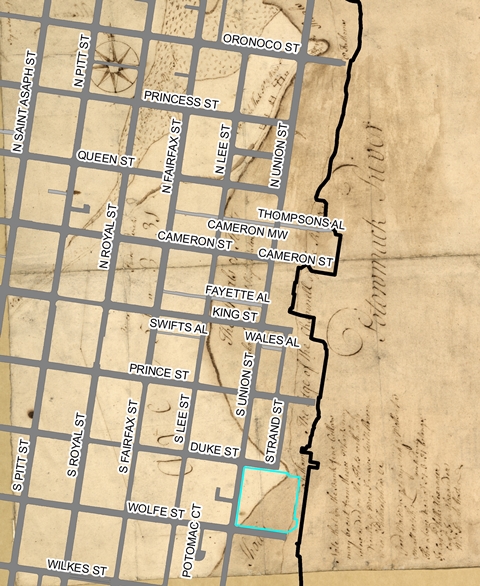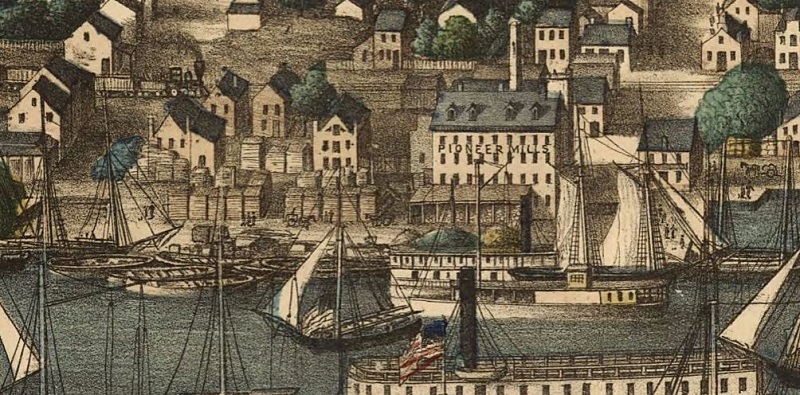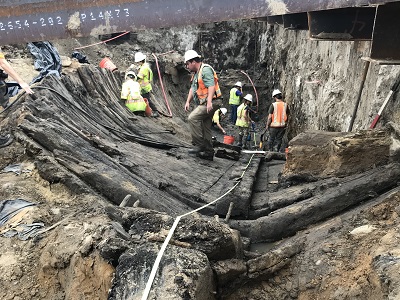
Archaeology at Robinson Terminal South
Archaeology at Robinson Terminal South

2 Duke Street
Located across Duke Street from the Hotel Indigo site (where archaeologists previously uncovered an 18th-century ship and warehouse) this site was until recently the site of a newsprint warehouse on Alexandria’s waterfront. It is now the site of EYA’s Robinson Landing development.
Archaeologists located the remains of three more 18th century ships, as well as foundations of Hooe's 18th century warehouse and store and the 19th century Pioneer Mill.
Learn more about Archaeology on the Waterfront, or go on a self-guided Scavenger Hunt of Robinson Landing.
The remains of the three ships are now stored in a pond in a manner that preserves the possibility of future study and conservation when adequate funding and/or a location for permanent storage or display is available. Learn more about the Historic Ship Stabilization Project.
Read the site report:
- Robinson Terminal South, 44AX235: 2025 Volume I
- Robinson Terminal South, 44AX235: 2025 Volume II
- Robinson Terminal South, 44AX235: 2025 Volume III
- Robinson Terminal South, 44AX235: 2025 Volume IV
- Robinson Terminal South, 44AX235: 2025 Volume V
- Robinson Terminal South, 44AX235: 2025 Volume VI
Historic Context

Currently bounded by Duke, Wolfe and S. Union Streets and the Potomac River, only the northwest corner of the block existed as dry land when a young George Washington made this map of the area in 1748. This point of land was called Point Lumley, one of the two original deep-water landings in Alexandria. The remainder of the block was created as a part of the same late 18th and early 19th century banking-out process that created new land along Alexandria’s waterfront.
Learn more about the sites below in the Field Excavation Updates (2017-2018).
18th Century Ships and the Bulkhead Wharves: A likely interpretation of how three ships came to be buried on this block is that once they were past their prime as sea-going vessels, they were used as fill to extend the City’s shoreline into the Potomac. By 1780 The Strand, a 21-foot wide alley running north-south, was built atop the wharf structures. Most of the block was filled in and the outline of the original Point Lumley had disappeared by the turn of the 19th-century, but the construction of wharves and filling in of the shore continued to take place at least into the 1840s. Read about the historic ship stabilization project.
The 1783 Hooe Warehouse: Robert Townsend Hooe built a large warehouse with a massive stone foundation. This warehouse played an important role in Alexandria’s early trade and commercial history. A Mutual Assurance Fire insurance policy taken out by Hooe in 1796 identified the foundations of 72’ long by 44’ wide warehouse, which he insured for 9,000 dollars. The warehouse was demolished at some time in the 19th century, replaced by the building still standing at 2 Duke Street.
The 1786 Bakery: After archaeologists recovered a surviving piece of hardtack, or ship’s biscuit, documentary research revealed that nearby structures included a bakehouse first advertised by Bridget Kirk in 1786. The next year, the bakery was leased by Anderson and Jamieson, who advertised “all sorts of ship bread, and the fine small bread.” Jamieson operated the bakery at this location until 1802. In 1832, Jamieson built a three-story bakery a few blocks away, at the corner of North Lee Street (then called Water Street) and Thompson’s Alley. This later bakery continued in operation into the 1880s and was excavated by Alexandria Archaeology in 1997.
The 1854 Pioneer Mills: Built in 1854 for the Alexandria Steam Flour Company, Pioneer Mills was the largest steam flour mill in the United States. Its size was, however, a liability, and the mill too often sat idle. The mill was offered for sale in 1859 and was taken over by the Union Army during the Civil War for use as a commissary storehouse. After the war, the mill served a variety of uses until it was badly damaged during a cyclone in 1896 and then destroyed by fire in 1897. (The fire began at the Bryant Fertilizer Factory on the adjacent Hotel Indigo Site.) The partial remains stood as ruins until 1920, when the Emerson Engine Company built a machine shop on the footprint of the old mill. The machine shop was demolished in 1937 to make way for the Robinson Terminal South warehouses.
2 Duke Street: The historic brick building which remains on site was probably built sometime before 1877 and was extensively repaired after the fire of 1897. This building was used as offices by Robinson Terminal South, and is being incorporated into the new waterfront development.
Other Foundations and Features: Archaeologists located stone foundations of dwellings on S. Union Street that can be seen on a Civil War photograph. They also excavated a brick shaft (a privy or well) at the back of one of these structures, and uncovered box privies, barrel privies, and brick-lined privies elsewhere on the site.
Excavation Highlights

Excavation of Ship 3 at the Robinson Terminal South site (October 2018) - Three Ships Discovered at Robinson Landing (press release, April 2018)
- The 1783 Hooe Warehouse (field update, April 2017)
- The 1854 Pioneer Mills (field updates, September and November 2017)
Read about tree-ring dating (dendrochronology) of the ship timbers
Michael J. Worthington and Jane I. Seiter
- 2022 - The Tree-Ring Dating of Three Ships Excavated at the Robinson Landing Site (44AX0235), City of Alexandria, Virginia. Oxford Tree-Ring Laboratory, Baltimore, MD.
- 2019 - The Tree-Ring Dating of the Archeological Evaluation and Mitigation of Site 44AX0235, Robinson Landing, City of Alexandria, Virginia. WSSI #22335.04. Oxford Tree-Ring Laboratory, Baltimore, MD.
Excavation and Ship Preservation Updates
Field Excavation Updates(2017-2018)
Ship Preservation Updates(2019-2020)
Recent Updates (2021 to present)
- Ship Documentation, Ship Models, March 2021
The conservation team is creating both digital and physical models of the three ship remnants found at the Robinson Terminal South Site (44AX235). - Digital and Physical Model Progress, June 2021
The conservation team continues to create both digital and physical models of the three ship remnants found at the Robinson Terminal South Site (44AX235). - Historic Ship Stabilization: Ship Ponding, September 2021
This project includes the stabilization and storage of three historic ship remnants excavated at the Robinson Landing Site. The overall goal of the project is to transport and store the timbers in Ben Brenman Pond (4800 Brenman Park Dr.) in a manner that preserves the possibility of future study and conservation when adequate funding and/or a location for permanent storage or display is available. Planning for the longer-term storage of the historic ship timbers began shortly after the ships were discovered in 2018. - Ship Model Progress, December 2021
Work is nearly complete on the digital model of Ship 3. Work on the physical models is also progressing.